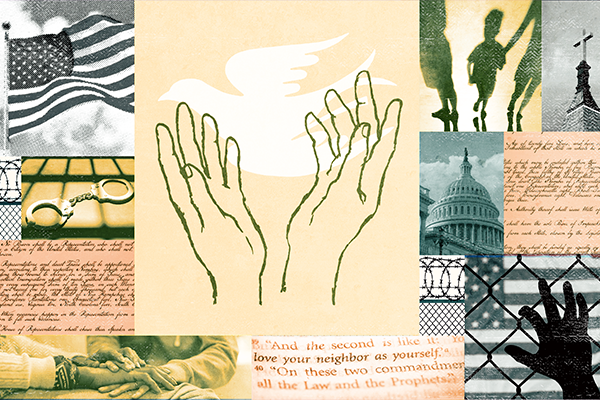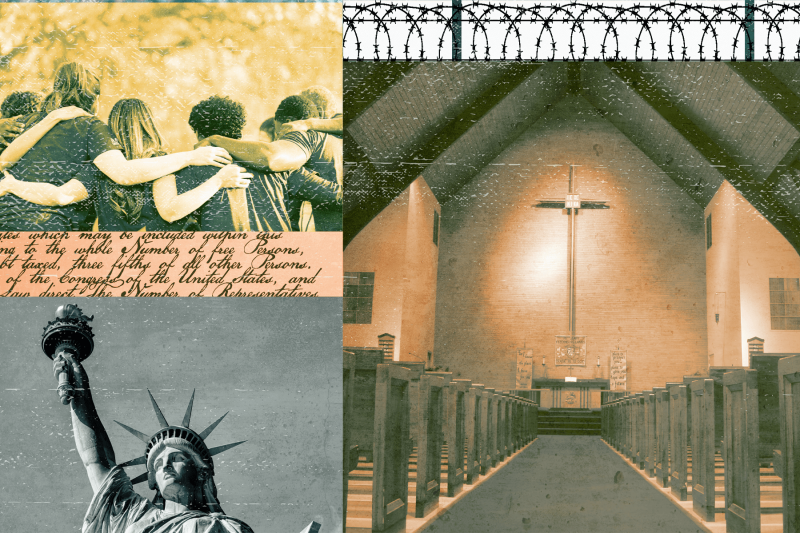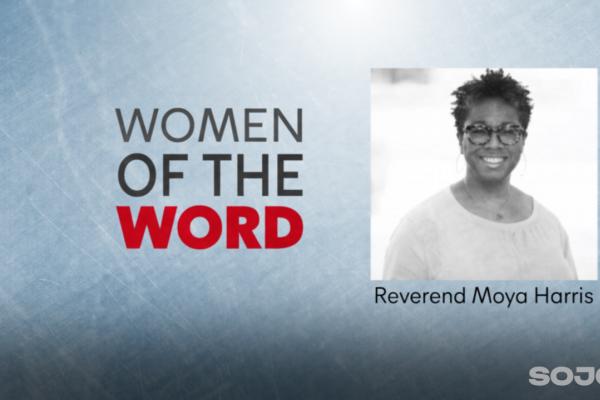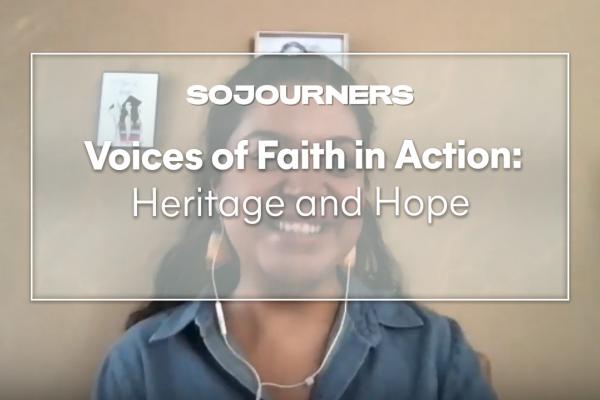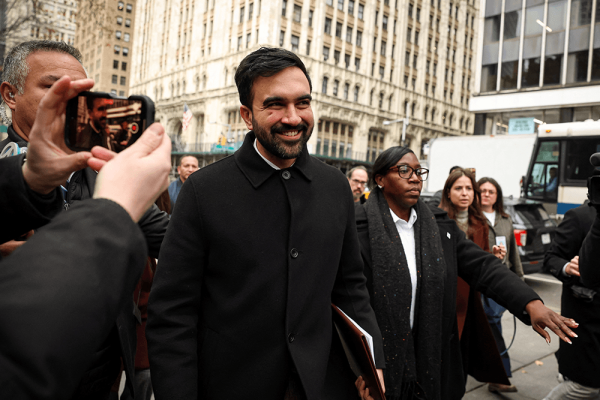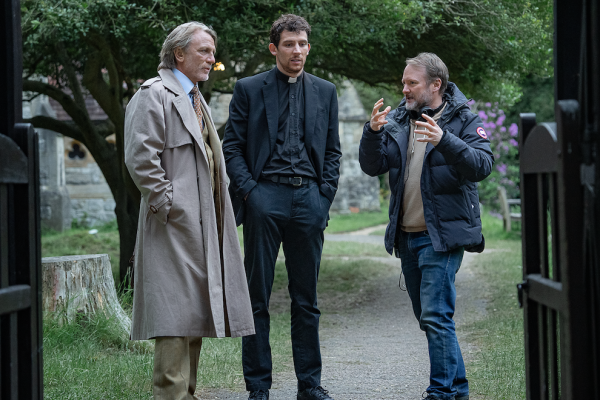“WE ARE FULL of fear, but we are not helpless,” said Giselle, a 40-year-old living in a mixed-status immigrant family in Chicago. “We have the power of God, the power of the church, and the power of the Holy Spirit on our side,” she said. (Sojourners is withholding Giselle’s last name due to her sensitive immigration status.)
Giselle is the mother of two children who are U.S. citizens. She is long settled in Chicago, having arrived two decades ago from Michoacán, Mexico. She lives in a three-bedroom apartment in Chicago’s Little Village — known as the “Mexico of the Midwest” or “La Villita” by locals — and works as a bookkeeper and worships at a local Pentecostal church where, she told Sojourners, there are other immigrants without permanent legal status singing next to her on Sundays. She volunteers and donates to local charities and generally tries to be a good neighbor — offering her time, talent, and treasure to others in her little corner of Chicago. Giselle said she has built her life in the U.S. and that her adolescent children know nothing else. “We are proud to be Mexican American, to live life here and be part of this community,” she said.
Like thousands of others across the U.S., Giselle and her family do not know how the Trump administration’s stated mass deportation policies will play out. But as policies are put in place and enforcement efforts ramp up, questions keep running through Giselle’s mind: How will I protect my family? What will happen to my immigration status? How will I be able to seek safety in the U.S.? “These are just some of the questions that handicap my ability to live,” she said.
As the Trump administration continues to implement its mass deportation plans, a swirling vortex of pain, fear, and uncertainty dominates the conversation among immigrants and faith communities across the nation. People of faith are responding with hope, resilience, and a steady resolve to be the best neighbors they can be to immigrants in need.
‘Shock and awe’
UNDER THE PREVIOUS Trump administration, there were around 2 million removals, returns, or expulsions under Title 42 restrictions, which allowed the U.S. to quickly turn back migrants at the U.S.-Mexico border in the name of protecting public health during the covid-19 pandemic. During Barack Obama’s two terms, there were more than 5 million removals or returns, leading some immigration reform advocates to dub Obama “deporter-in-chief.” Including Title 42 expulsions during covid, deportations during the Biden administration far outpaced both Trump and Obama.
But with fierce rhetoric on immigration and promises of mass deportation being a consistent theme of Trump’s reelection bid, immigrant communities, faith groups, and advocacy organizations have been bracing themselves for mass deportation on a scale rarely seen in U.S. history.
No matter who the president has been over the last 20 years, Giselle said she and her family have been in an almost steady state of fear. “We have already faced the fear of separation through deportation for years, the fear of accessing public services because we don’t know if we qualify or not,” Giselle said. But now, “the threats are multiplying.” Giselle said she has reason to worry that things will be worse than under Biden, Obama, or Trump’s first term. “Everything he’s said, everything he’s promised — I’ve never heard such things in all my life,” she said. “I fear he means what he says this time around.”
Giovana Oaxaca, migration policy program director for the Evangelical Lutheran Church in America (ELCA), said the Trump administration’s “shock and awe” — as new White House “border czar” Tom Homan said he plans — is dizzying in its scope.
There is a lot coming down the pipeline. It’s like drinking water out of a firehose. As of this writing, actions taken include the rescinding of “sensitive locations” protections for schools, hospitals, and places of worship; the expansion of expedited removal, in which officials can summarily remove certain noncitizens without a hearing; the suspension of the U.S. refugee admissions program; asylum restrictions and a swath of increased border security measures through executive orders. The administration also threatens removal of temporary protective status for hundreds of thousands; the escalation of detention and expansion of facilities from the previous 44,000 beds to more than 100,000; and the deportation of entire families and mass workplace raids. It is challenging the citizenship status for children born in the U.S. to immigrants living in the country without documentation.
All these plans and threats will face opposition in the courts. But their immediate impact is the fear and trepidation stirring in communities from Los Angeles to Washington, D.C., Oaxaca said.
Cities of angels
IN RESPONSE, ADVOCATES, leaders, and local organizers are “Trump-proofing” their congregations and communities. Guillermo Torres, who directs immigration outreach campaigns for Clergy and Laity United for Economic Justice (CLUE) in Los Angeles, remembers what it was like during the first Trump administration — how dark the shadow hanging over migrants was and how bright the response from faith communities in the City of Angels. “But things are different this time,” Torres said, “more shocking and painful than in 2016.”
The response, he said, must be equal to the challenge. Torres said that is why his organization is relaunching its “sacred resistance and sanctuary” program that started during the first Trump administration. This includes convening multiple efforts “with everyone from Pentecostals to Presbyterians,” he said. CLUE offers training around sanctuary in faith communities, nonviolent civil disobedience, and recruiting criminal and civil rights attorneys to provide support for faith leaders. CLUE is also organizing clergy and lay leaders into rapid response networks in the Los Angeles metroplex that can provide a plan of action for communities to support and guide people during and after raids by Immigration and Customs Enforcement (ICE) or local authorities.
Torres said they are also conducting “Know Your Rights” trainings at congregations and other faith communities across their network. Sithy Bin, a faith-rooted organizer and preacher at nondenominational Testimony Ministries in Los Angeles, said Know Your Rights training, which provides immigrants with tools and practices necessary to navigate the immigration system, are invaluable at such a time. “Many people in the congregation know very little,” Bin said, “but knowing your rights around unlawful search and seizure, what ICE can and cannot do, what authority they have and don’t have, can mean all the difference.”
Bin fears the mass deportation agenda will hurt multiple generations of families. And he would know. Bin was born in a Cambodian refugee camp in Thailand and came to the U.S. as a toddler; the U.S. is the only home Bin has ever known. As a young man, he joined a gang and served time in prison, where he found his faith and became an ordained minister. Upon parole, on the day Bin was to return to his family, ICE arrested him and took him to the Mesa Verde detention facility in Bakersfield, Calif. Since Bin’s release, he has worked to contribute to his community and remain with his two daughters and two grandchildren. “Mass deportation is going to separate families of multiple generations,” Bin said, “and there will be a ripple effect, not only harming the person you are deporting, but the wife, the mother, the son, the grandchildren, the sister, the daughter, the whole community.”
Know Your Rights training, said Mary Campbell of ELCA’s migrant accompaniment ministry, can make all the difference in keeping families together. That is why she is encouraging congregations across her denomination to host gatherings and invite migrant communities to access information to prepare, “so that they can better protect themselves should ICE come to their location and try to detain individuals,” she said.
The ancient claim of sanctuary
ANOTHER WAY FAITH communities are responding is by revitalizing the Sanctuary Movement. The original movement began as a religious coalition of churches and synagogues that worked on multiple fronts to provide safe haven, protection, material goods, and legal advice to Central American refugees denied asylum in the U.S. It began in 1982 at Southside Presbyterian Church in Tucson, Ariz., and swiftly spread across the country. At its height in 1986 and 1987, the movement included more than 400 congregations and claimed between 60,000 to 70,000 participants. The movement traced its roots to the biblical tradition of sanctuary, where persons fleeing vigilantism or demanding due process of the law could ask for protection at places of worship.
Houses of worship have continued to protect undocumented immigrants at risk of deportation by offering them refuge in churches, where federal agents still hesitate to tread. Pastor Noel Andersen, national field director for Church World Service (CWS), plays a key role in the New Sanctuary Movement, which ramped up its efforts during the first Trump administration. Now, Andersen said, CWS is helping the sanctuary network prepare for “deportation defense” in the form of accompaniment, rapid response, and mutual aid. He said they anticipate very few public sanctuary legal cases but will continue to advocate for local and state pro-sanctuary policies and funding.
When sources close to Trump leaked in December that his administration intends to scrap “sensitive locations” protections — granting ICE officers more power to arrest undocumented people at churches, schools, hospitals, and other long-protected public spaces — CWS joined others in protest. “The right for all people to find safety, refuge, and rest in houses of worship is fundamental to our nation’s history of religious freedom and our longstanding values,” Andersen said. “No one should face fear of deportation when going to houses of worship, seeking medical care, social services, at public demonstrations, or taking their kids to school.”
Sergio M. González, history professor at Marquette University, said those looking to provide sanctuary to undocumented individuals should take notes from the movement’s history: “At its root, sanctuary has always consisted of two key aspects: humanitarian aid — providing immediate support to those in need — and political action — working to shift both public consciousness and public policy. This ... should serve as a model for whatever comes in 2025.” But, González warned, faith leaders on the ground will face far more barriers than sanctuary activists have ever faced before. “They’ll have to contend with an American public that is more antagonistic toward undocumented immigrants, as well as churches with fewer resources. There’s also the issue of a deportation apparatus that has grown larger and more advanced, with more access to surveillance technology.”
Perhaps most important, González said, “they’ll be staring down a Trump administration that has made anti-sanctuary policies a bedrock of its immigration politics, which means the executive branch will be focused on going after all forms of sanctuary, secular or faith-based.” For Andersen, this means that organizations such as CWS are going to have to help “shift negative narratives against newcomers and equip our community partners to defend and support immigrants.”
‘Walk with us’
ADVOCATES SAY THE process begins by knowing our own story and listening to those of our neighbors. Every faith leader who spoke with Sojourners said this is the time for people of faith to live out the values of compassion and justice that their traditions teach. Chieko Noguchi, spokesperson for the U.S. Conference of Catholic Bishops, said the work of the conference is to serve all who come to them in need, which is founded in the “gospel mandate” that “every human being is created in God’s image with an inherent dignity and deserves respect.”
Jesús de la Torre and Aimée Santillán from the Hope Border Institute in El Paso, Texas, say this means “we must reject the idea that our immigration system needs to cause harm in order to be orderly and efficient.” Such a shift will only happen by developing authentic relationships with people directly impacted by mass deportations and other actions threatened by the current administration.
Whether through convenings at local churches to listen to migrants directly, connecting with and supporting migrant organizations already doing the work in their communities, or joining advocacy groups to participate in public policy debates and send messages to members of Congress, there are multiple ways to stand in solidarity with migrants at this moment, the faith leaders told Sojourners. “We often look at our leaders to be voices for justice, for hope,” said the ELCA’s Oaxaca. But “people themselves can be voices of justice and hope by participating in advocacy,” she said. “Now, more than ever, we will need people to be engaged — to follow the developments along with us, walk with us, and mobilize swiftly to stand up for their values.”
In other words, everyday people of faith may end up being a lifeline to families such as Giselle’s, who face increased fear and uncertainty. Giselle knows that if help is needed, it will come from people in Little Village and the wider Chicago area, whether it be the person on the other end of the hotline number she’s memorized for emergency support, the lawyer that she heard offers free legal advice, or the local contacts who will pick up her kids if she is apprehended by ICE.
Beyond that, Giselle is unsure of what more she can do to avoid deportation or keep her family together. At the very least, she said, “I will trust in my God, I will trust in my church to help me, and I will turn to my neighbor — to help and be helped in such a time of need.”

Got something to say about what you're reading? We value your feedback!
